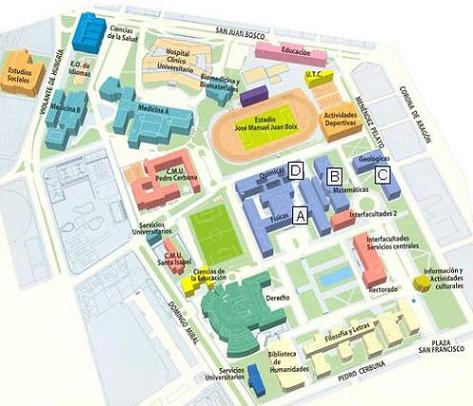Location

Zaragoza: where we are
Zaragoza is the capital city of the autonomous region of Aragón and it is Spain´s fifth largest city with more than 600,000 inhabitants. Its position halfway between Madrid and Barcelona (both less than two hours away) and within easy reach to France, Bilbao and the Mediterranean coast, makes it a convenient centre of communication. Zaragoza has a pleasant, fairly dry continental climate.
The Faculty of Science at the University of Zaragoza has a long and distinguished history in teaching and research, attracting students from all over the world.
Our Faculty is located at the centre of Zaragoza in the San Francisco campus. There are four main buildings: A (Secretarial staff and Physics), B (Mathematics and Statistics), C (Geology) and D (Chemistry).

The city of Zaragoza
Zaragoza is a pleasant, prosperous, lively and affordable university town.
Situated in the Ebro valley, Zaragoza lies 200 metres above sea level. The Ebro river, the largest in Spain, runs through the city. Los Monegros, one of the driest areas in Spain, very close to Zaragoza is always the visitor's favourite sight, especially those from wetter central and Northern European countries. The city is also within easy reach to the Pyrenees.
Zaragoza is now a very modern Spanish city but abundant traces of its long history can be found everywhere in its streets and squares. The cathedral of San Salvador (also called La Seo), originally a mosque, is a masterpiece of local Gothic and an illustration of the layering of various cultures that characterise the city's history, including Romanesque, Mudéjar, Baroque and other architectural styles. Other monuments, like the Aljafería Moorish palace, now the seat of the Aragonese Parliament, or the huge basilica of El Pilar, a centre of Catholic devotion around the Spanish-speaking world, are well worth visiting. The best known cultural figures associated with Zaragoza are the painter Francisco de Goya, some of whose paintings and etchings can be seen in the city museums, and filmmaker Luis Buñuel. Nevertheless, Zaragoza has much more to offer the visitor: its wide, graceful avenues, its parks and squares, the varied cuisine of its restaurants and the local "tapas" in bars and cafés, its lively night life and the famed hospitality of its people all contribute to providing the visitor with an experience of life in a Spanish city outside the more famous tourist areas.
Travel video of Zaragoza
(Source: The Independent. Simon Calder. Marzo 2008)
Language
Exchange students are not required to take any test of proficiency in the Spanish language at our institution. However, since most courses are lectured in Spanish and your daily meetings with Spanish people will rarely be in English, we do encourage incoming students to take courses in Spanish prior to and on arrival in case of feeling a weak command of the language.
Money matters
Spain´s currency is the Euro (€). If you need to change money you should do so at a bank office. Exchange offices are rarely found in our city.
Credit cards and automatic cash-dispensers are widely used in Spain. You will find ATMs in shopping centres, within the San Francisco campus (Information building) and on most main streets.
If you want to open a bank account you will need to show your passport or ID Card for identification purposes.
The weather
Zaragoza has got a continental/Mediterranean and rather dry climate. As in many similar areas, the weather in Zaragoza can tend towards extremes and is at times especially windy. The wind even merits its own name: you will soon feel the "cierzo". Temperatures are moderate but extremes of 35ºC in summer and below 0ºC in winter are not uncommon.
Electricity
The standard voltage is 220V. Two-pin plugs are standard on most electrical equipment. Adapters can be bought at electrical suppliers and supermarkets.
Daily routine
The working day normally starts at 8 or 9 a.m. and finishes at 6 or 7 p.m. with a two-hour-break for lunch. At the university, lectures may even run until 9.00 p.m.
Shops open from 9.30 to 13.30 in the morning and from 17.00 to 20.30 in the evening.
Supermarkets and shopping centres are normally open from 9.00 to 21.00 or 10.00 to 22.00, Monday to Saturday.
Bank opening hours may vary from one bank to another but they normally open at 8.30 and close at 14.00.
As for meals, lunch is usually at about 14.00 and dinner at about 21.00 or a bit later. Restaurants have more varied opening hours and the university canteens start serving lunch at 13.00.
